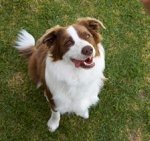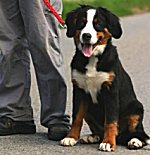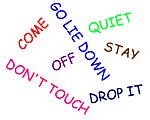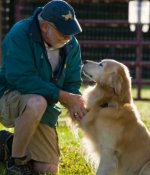Chinese Cresteds: What's Good About 'Em, What's Bad About 'Em
Powderpuff and Hairless Chinese Crested temperament, personality, training, behavior, pros and cons, advice, and information, by Michele Welton, Dog Trainer, Behavioral Consultant, Author of 15 Dog Books

The Chinese Crested is fine-boned, elegant, and graceful. And the Hairless variety is certainly unique-looking!
High-spirited and happy, animated and agile, the Chinese Crested is an adept climber and jumper.... which sounds cool, except that some individuals are clever escape artists who can scale high fences or dig under them.
This people-oriented "Velcro" dog depends emotionally on his owner for a lot of personal interaction. When you pick him up, he may grip your neck tightly with his paws (although he does the same thing with toys – he is quite adept at controlling his toes!)
Because he is a needy dog, he doesn't like being left for long without companionship. Separation anxiety may set in, and then he is prone to "acting out" to relieve his anxiety. For example, destructive chewing.
Reserved with strangers, some Crested lines and individuals are high-strung and/or timid with new people and new situations. Early and frequent socialization will help build a confident, stable temperament.
Chinese Cresteds are usually playful with (though sometimes jealous of) other pets.
Though independent and somewhat willful, the Chinese Crested is also bright and responds reasonably well to the discipline he needs to control his inquisitive activities.
Unfortunately, housebreaking is very difficult. Unneutered males are especially challenging, as they are inclined to excessive marking of territory (i.e. lifting their leg in your house!)
Some Chinese Cresteds are quite vocal and will bark (or howl) too much.
If you want a dog who...
- Is small, elegant, and exotic-looking
- Comes in hairless and coated varieties, and many colors
- Doesn't shed much
- Is high-spirited, animated, and agile
- Makes a keen watchdog, but is not aggressive with strangers
- Is usually good with other pets
A Chinese Crested may be right for you.
If you don't want to deal with...
- The fragility of toy breeds (see below)
- High activity level
- "Separation anxiety" (destructiveness and barking) when left alone too much
- Timidity or fearfulness in some lines, or when not socialized enough
- Stubborness (a mind of his own)
- Notorious housebreaking difficulties
- Tendencies to climb or dig to escape from confinement
- Barking
- With the hairless variety, a commitment to skin care
- With the powderpuff variety, a commitment to brushing and combing
A Chinese Crested may not be right for you.
 |
Dog Breed Traits – Which Traits Are Right For You? In this brand new series, I'll help you decide which dog breed traits would best suit you and your family, your home and yard, and your lifestyle, so you can choose the best dog breed for your family. |
Keep in mind that the inheritance of temperament is less predictable than the inheritance of physical traits such as size or shedding. Temperament and behavior are also shaped by raising and training.
FREE eBooks by Michele Welton
![]() "Respect Training for Puppies" and "Teach Your Dog 100 English Words" are free step by step guides to teaching your pup to be calm and well-behaved.
"Respect Training for Puppies" and "Teach Your Dog 100 English Words" are free step by step guides to teaching your pup to be calm and well-behaved.
![]() "11 Things You Must Do Right To Keep Your Dog Healthy and Happy" is a free guide to keeping your dog mentally, physically, and emotionally happy and healthy so you can enjoy a longer lifetime of companionship.
"11 Things You Must Do Right To Keep Your Dog Healthy and Happy" is a free guide to keeping your dog mentally, physically, and emotionally happy and healthy so you can enjoy a longer lifetime of companionship.

- You can avoid some negative traits by choosing an ADULT dog from an animal shelter or rescue group. With an adult dog, you can easily see what you're getting, and plenty of adult Cresteds have already proven themselves not to have negative characteristics.
- If you want a puppy, you can avoid some negative traits by choosing the right breeder and the right puppy.
More traits and characteristics of the Chinese Crested
If I was considering a Chinese Crested, I would be most concerned about...
- Fragility. Too many people acquire a toy breed puppy without understanding how fragile a toy breed is. You can seriously injure or kill a Chinese Crested puppy by stepping on him or by sitting on him when he's curled under a blanket or pillow, where he frequently likes to sleep. And Chinese Crested puppies can seriously injure or kill THEMSELVES by leaping from your arms or off the back of your sofa. A larger dog can grab a Crested puppy and break his neck with one quick shake. Owning a toy breed means constant supervision and surveillance of what's going on around your small dog. Chinese Cresteds should be kept indoors, in a safely fenced yard, or on-leash – they are just too easy to injure when not under your complete control.
Chinese Crested puppies are not suited to young children, no matter how well-meaning the child. Children cannot help being clumsy, and that a child meant well is little solace to a Chinese Crested puppy who has been accidentally stepped on, sat on, rolled on, squeezed, or dropped onto the patio. Even Chinese Crested adults may feel overwhelmed by the loud voices and quick movements that children can't help making – and stress and shyness (even defensive biting) may be the result.
- Potential separation anxiety. More than most other breeds, Chinese Cresteds need a great deal of companionship and do not like being left alone for more than a few hours. They become anxious, which they express by destructive chewing and barking. If you work all day, this is not the breed for you.
- Providing enough socialization. Standoffish by nature, Chinese Cresteds need extensive exposure to people and to unusual sights and sounds. Otherwise their natural caution can become shyness or suspiciousness, which are difficult to live with.
- Housebreaking. As a behavioral consultant, I would put the Chinese Crested on my Top 10 List of "Hard to Housebreak." Consistent crate training is mandatory. Sometimes a doggy door is necessary. And some owners never do get their Chinese Cresteds fully housebroken.
- Mind of his own. Chinese Cresteds can be stubborn and manipulative. You must show them, through absolute consistency, that you mean what you say. To teach your Chinese Crested to listen to you and respect you, follow my free online training program.
- Fence security. Many Chinese Cresteds climb like monkeys and dig like gophers. You may need higher fences than you might imagine for their small size. You may also need to sink wire into the ground along the fence line to thwart digging.
- Potential barking. Chinese Cresteds are often too quick to sound the alarm at every new sight and sound. You have to be equally quick to stop them so they don't turn into yapping nuisances.
- Skin care. Hairless Chinese Cresteds have delicate skin that must be frequently washed and moisturized.
- Grooming. Powderpuff Chinese Cresteds become a matted mess without frequent brushing and combing. If you can't commit to the brushing, you have to commit to frequent trimming to keep the coat short, neat, and healthy. As a bonus, they look extra-cute when the coat is short!
My best-selling books – now available FREE on my website
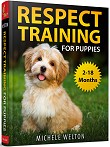 Respect Training For Puppies: 30 seconds to a calm, polite, well-behaved puppy is for puppies 2 to 18 months old. Your puppy will learn the 21 skills that all family dogs need to know. Click here to read for free.
Respect Training For Puppies: 30 seconds to a calm, polite, well-behaved puppy is for puppies 2 to 18 months old. Your puppy will learn the 21 skills that all family dogs need to know. Click here to read for free.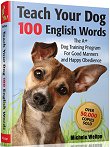 Teach Your Dog 100 English Words is a unique Vocabulary and Respect Training Program that will teach your adult dog to listen to you and do what you say. Click here to read for free.
Teach Your Dog 100 English Words is a unique Vocabulary and Respect Training Program that will teach your adult dog to listen to you and do what you say. Click here to read for free.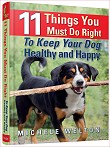 11 Things You Must Do Right To Keep Your Dog Healthy and Happy helps your dog live a longer, healthier life. Get my honest advice about all 11 Things before you bring home your new puppy, because some mistakes with early health care cannot be undone. Click here to read for free.
11 Things You Must Do Right To Keep Your Dog Healthy and Happy helps your dog live a longer, healthier life. Get my honest advice about all 11 Things before you bring home your new puppy, because some mistakes with early health care cannot be undone. Click here to read for free.Related posts you might enjoy



